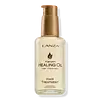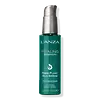What's inside
What's inside
 Key Ingredients
Key Ingredients

 Benefits
Benefits

 Concerns
Concerns

 Ingredients Side-by-side
Ingredients Side-by-side

Cyclopentasiloxane
EmollientDimethicone
EmollientCaprylyl Methicone
Skin ConditioningCrambe Abyssinica Seed Oil
Skin ConditioningOrbignya Speciosa Kernel Oil
EmollientAstrocaryum Murumuru Seed Butter
EmollientKeratin Amino Acids
Skin ConditioningEuterpe Oleracea Fruit Oil
Skin ConditioningCoffea Arabica Seed Oil
MaskingCereus Grandiflorus Flower Extract
Skin ConditioningDimethiconol Meadowfoamate
EmollientSodium PCA
HumectantMagnesium PCA
HumectantZinc PCA
HumectantManganese PCA
HumectantIsopropyl Palmitate
EmollientTrimethylsiloxyamodimethicone
Benzotriazolyl Dodecyl P-Cresol
UV AbsorberPolysilicone-15
UV FilterPropylene Glycol
HumectantWater
Skin ConditioningParfum
MaskingCinnamyl Alcohol
PerfumingAlpha-Isomethyl Ionone
PerfumingCI 26100
Cosmetic ColorantCI 47000
Cosmetic ColorantCyclopentasiloxane, Dimethicone, Caprylyl Methicone, Crambe Abyssinica Seed Oil, Orbignya Speciosa Kernel Oil, Astrocaryum Murumuru Seed Butter, Keratin Amino Acids, Euterpe Oleracea Fruit Oil, Coffea Arabica Seed Oil, Cereus Grandiflorus Flower Extract, Dimethiconol Meadowfoamate, Sodium PCA, Magnesium PCA, Zinc PCA, Manganese PCA, Isopropyl Palmitate, Trimethylsiloxyamodimethicone, Benzotriazolyl Dodecyl P-Cresol, Polysilicone-15, Propylene Glycol, Water, Parfum, Cinnamyl Alcohol, Alpha-Isomethyl Ionone, CI 26100, CI 47000
Cyclopentasiloxane
EmollientDimethicone
EmollientCaprylyl Methicone
Skin ConditioningDiphenylsiloxy Phenyl Trimethicone
Skin ConditioningPerfluorononyl Dimethicone
Skin ConditioningMelia Azadirachta Extract
Skin ConditioningKeratin Amino Acids
Skin ConditioningSantalum Album Extract
CleansingPhellodendron Amurense Bark Extract
Skin ConditioningHordeum Distichon Extract
Skin ProtectingDimethiconol Cysteine
Ceramide NP
Skin ConditioningSodium Hyaluronate
HumectantDimethicone PEG-8 Meadowfoamate
EmollientSodium PCA
HumectantZinc PCA
HumectantMagnesium PCA
HumectantManganese PCA
HumectantCitrus Limon Fruit Extract
MaskingFumaria Officinalis Flower/Leaf/Stem Extract
Skin ConditioningHelianthus Annuus Seed Oil
EmollientSqualane
EmollientFumaric Acid
BufferingEthylhexyl Methoxycinnamate
UV AbsorberTetrahexyldecyl Ascorbate
AntioxidantTrimethylsiloxyamodimethicone
Ascorbyl Methylsilanol Pectinate
AntioxidantButylene Glycol
HumectantWater
Skin ConditioningBenzotriazolyl Dodecyl P-Cresol
UV AbsorberParfum
MaskingAlpha-Isomethyl Ionone
PerfumingBenzyl Salicylate
PerfumingButylphenyl Methylpropional
PerfumingCitronellol
PerfumingCoumarin
PerfumingGeraniol
PerfumingLimonene
PerfumingLinalool
PerfumingCyclopentasiloxane, Dimethicone, Caprylyl Methicone, Diphenylsiloxy Phenyl Trimethicone, Perfluorononyl Dimethicone, Melia Azadirachta Extract, Keratin Amino Acids, Santalum Album Extract, Phellodendron Amurense Bark Extract, Hordeum Distichon Extract, Dimethiconol Cysteine, Ceramide NP, Sodium Hyaluronate, Dimethicone PEG-8 Meadowfoamate, Sodium PCA, Zinc PCA, Magnesium PCA, Manganese PCA, Citrus Limon Fruit Extract, Fumaria Officinalis Flower/Leaf/Stem Extract, Helianthus Annuus Seed Oil, Squalane, Fumaric Acid, Ethylhexyl Methoxycinnamate, Tetrahexyldecyl Ascorbate, Trimethylsiloxyamodimethicone, Ascorbyl Methylsilanol Pectinate, Butylene Glycol, Water, Benzotriazolyl Dodecyl P-Cresol, Parfum, Alpha-Isomethyl Ionone, Benzyl Salicylate, Butylphenyl Methylpropional, Citronellol, Coumarin, Geraniol, Limonene, Linalool
Ingredients Explained
These ingredients are found in both products.
Ingredients higher up in an ingredient list are typically present in a larger amount.
Alpha-Isomethyl Ionone is a fragrance. It can be synthetically created or naturally occurring.
The scent of Alpha-Isomethyl Ionone is described as "flowery" but can also be "woody".
Naturally occurring Alpha-Isomethyl Ionone may be found in Saccharomyces cerevisiae, or the yeast used to make wine and bread.
The term 'fragrance' is not regulated in many countries. In many cases, it is up to the brand to define this term. For instance, many brands choose to label themselves as "fragrance-free" because they are not using synthetic fragrances. However, their products may still contain ingredients such as essential oils that are considered a fragrance.
Learn more about Alpha-Isomethyl IononeBenzotriazolyl Dodecyl P-Cresol, also known as Tinogard TL, is a broad-spectrum UV absorber.
It helps stabilize light-sensitive ingredients and protects other ingredients from breaking down due to light exposure (especially in transparent packaging).
This ingredient helps extend a product’s shelf life by preventing both photolytic (light-induced) and photo-oxidative degradation. It’s typically used at low concentrations, around 0.01% to 0.1%.
Despite being a chemical UV filter, this ingredient can be found in "100% mineral sunscreens". This is due to regulatory loopholes.
Learn more about Benzotriazolyl Dodecyl P-CresolCaprylyl Methicone is a type of silicone.
It helps soften and soothe the skin by creating a thin film on top. This film helps trap moisture, keeping your skin hydrated.
Cyclopentasiloxane, or D5, is a silicone used to improve texture of products and trap moisture.
D5 is considered lightweight and volatile. Volatile means it evaporates quickly after application. Once evaporated, D5 leaves a thin barrier that helps keep skin hydrated.
It is also an emollient. Emollients help soften the skin and prevent water loss. Silicones create a silky texture in products. D5 helps other ingredients become more spreadable.
Studies show D5 is safe to use in skincare products. We recommend speaking with a skincare professional if you have concerns.
Learn more about CyclopentasiloxaneDimethicone is a type of synthetic silicone created from natural materials such as quartz.
What it does:
Dimethicone comes in different viscosities:
Depending on the viscosity, dimethicone has different properties.
Ingredients lists don't always show which type is used, so we recommend reaching out to the brand if you have questions about the viscosity.
This ingredient is unlikely to cause irritation because it does not get absorbed into skin. However, people with silicone allergies should be careful about using this ingredient.
Note: Dimethicone may contribute to pilling. This is because it is not oil or water soluble, so pilling may occur when layered with products. When mixed with heavy oils in a formula, the outcome is also quite greasy.
Learn more about DimethiconeWe don't have a description for Keratin Amino Acids yet.
This ingredient is the magnesium salt of PCA (Pyrrolidone Carboxylic Acid). It is a great skin hydrator for the top layers of skin.
PCA is a natural humectant, meaning it draws water from the air to your outer layer of skin.
One study found magnesium ions improved skin hydration in the outer layer of skin, or the stratum corneum. However, it did not improve TEWL, or the transepidermal water loss. The TEWL is an indicator of how healthy your skin barrier function is. This study primarily looked at healthy skin with intact skin barrier.
Learn more about Magnesium PCAWe don't have a description for Manganese PCA yet.
Parfum is a catch-all term for an ingredient or more that is used to give a scent to products.
Also called "fragrance", this ingredient can be a blend of hundreds of chemicals or plant oils. This means every product with "fragrance" or "parfum" in the ingredients list is a different mixture.
For instance, Habanolide is a proprietary trade name for a specific aroma chemical. When used as a fragrance ingredient in cosmetics, most aroma chemicals fall under the broad labeling category of “FRAGRANCE” or “PARFUM” according to EU and US regulations.
The term 'parfum' or 'fragrance' is not regulated in many countries. In many cases, it is up to the brand to define this term.
For instance, many brands choose to label themselves as "fragrance-free" because they are not using synthetic fragrances. However, their products may still contain ingredients such as essential oils that are considered a fragrance by INCI standards.
One example is Calendula flower extract. Calendula is an essential oil that still imparts a scent or 'fragrance'.
Depending on the blend, the ingredients in the mixture can cause allergies and sensitivities on the skin. Some ingredients that are known EU allergens include linalool and citronellol.
Parfum can also be used to mask or cover an unpleasant scent.
The bottom line is: not all fragrances/parfum/ingredients are created equally. If you are worried about fragrances, we recommend taking a closer look at an ingredient. And of course, we always recommend speaking with a professional.
Learn more about ParfumSodium PCA is the sodium salt of pyroglutamic acid. It is naturally occurring in our skin's natural moisturizing factors where it works to maintain hydration.
The PCA stands for pyrrolidone carboxylic acid, a natural amino acid derivative.
This ingredient has skin conditioning, anti-inflammatory, and humectant properties. Humectants help hydrate your skin by drawing moisture from the air. This helps keep your skin moisturized.
Learn more about Sodium PCATrimethylsiloxyamodimethicone (don't worry, we cannot pronounce this either) is a siloxane polymer. Siloxane polymers are widely used as antimicrobials and texture enhancer. This ingredient is synthetically created.
As a silicone, Trimethylsiloxyamodimethicone helps hydrate and smooth the skin. It can also be found in hair care products.
Trimethylsiloxyamodimethicone is described as "non-greasy" and "silky".
Learn more about TrimethylsiloxyamodimethiconeWater. It's the most common cosmetic ingredient of all. You'll usually see it at the top of ingredient lists, meaning that it makes up the largest part of the product.
So why is it so popular? Water most often acts as a solvent - this means that it helps dissolve other ingredients into the formulation.
You'll also recognize water as that liquid we all need to stay alive. If you see this, drink a glass of water. Stay hydrated!
Learn more about WaterZinc PCA (or "zinc salt") differs slightly from zinc itself. PCA stands for pyrrolidone carboxylic acid. However, Zinc PCA comes from zinc.
It can help reduce redness, regulate sebum, and promote the general healing process of the skin.
Zinc PCA tends to be especially useful for those with oily, acne-prone skin. It's certainly an ingredient worth trying out!
Learn more about Zinc PCA